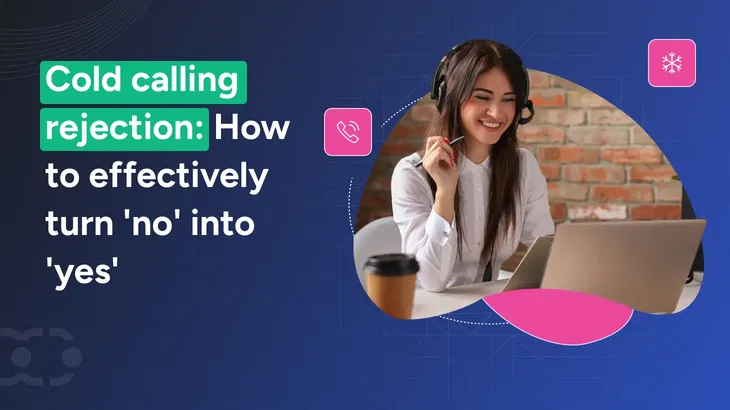3. Timing matters
Reaching prospects during optimal hours increases your chances of connection. If you don't know, the study reveals Wednesdays have a 50% higher success rate for first-call conversations than Mondays or Fridays.
How to do it:
- Call during high-response times: 11 a.m.–12 p.m. or 4 p.m.–5 p.m.
- Use time-zone-based dialing tools to avoid interruptions outside of business hours.
4. Focus on value
Value selling always works, so demonstrate how your product or service solves their problems and builds trust and credibility.
How to do it:
- Reframe your pitch around their needs:
Instead of saying, "Our tool tracks sales data," say, "Our tool can help you reduce lead response time by 50%, improving conversions."
- Use success stories to illustrate impact:
"We recently helped [similar company] cut costs by 30% with our solution."
5. Handle objections effectively
Objections often aren't outright rejections. They're a sign the prospect has concerns or needs more information.
How to do it:
- Acknowledge their concerns empathetically:
"I understand budget constraints can be tough. Would it help if I shared a case study showing how we delivered ROI within six months?"
- Prepare retorts for common objections:
"We already have a solution."
Response: "How does your current solution handle [specific challenge]?"
"Now's not a good time."
Response: "I completely understand. Would it be better to reconnect next quarter?"
6. Follow up strategically
Most sales don't happen on the first call. Effective follow-ups keep your prospects engaged and remind them of your value.
How to apply it:
- Schedule timely follow-ups: Use your CRM to set reminders and plan your outreach.
- Share value-driven resources: Follow up with case studies, reports, or articles that address their pain points.
- Be persistent yet respectful: Many prospects need multiple touchpoints before engaging.
Here is how you set follow-up on Sequences with Salesmate CRM:
7. Leverage technology
Sales tools like CRMs and cold call dialers streamline your workflow, saving time and improving results.
AI tools can boost leads and appointments by up to 50%, making technology indispensable in cold calling.
How to apply it:
- Use sales dialers: Call multiple prospects efficiently and optimize your time.
- Track interactions with CRM tools: Analyze trends, monitor rejection patterns, and refine your targeting.
- Incorporate AI sales tools: Automate routine tasks like scheduling follow-ups and managing call data.
8. Review and refine your approach
The best salespeople are constantly improving their techniques based on feedback and results.
How to apply it:
- Listen to call recordings: Identify what went well and what didn't.
- Seek feedback from peers or mentors: Role-playing can help uncover blind spots.
- Refine scripts and strategies: Make adjustments based on rejection trends and successful interactions.
9. Build resilience with a growth mindset
Maintaining a positive attitude helps you bounce back after challenging phone calls. Set effort-based goals and celebrate progress.
How to apply it:
- Reframe rejection as feedback: Each "no" provides an opportunity to learn and improve.
- Set effort-based goals: Focus on the number of calls made or follow-ups completed instead of immediate outcomes.
- Find support: Join sales communities or connect with mentors for shared insights and encouragement.
5 Immediate moves to bounce back after cold call rejection
Instead of letting cold call rejection affect your morale or performance, use these five actionable steps to bounce back stronger and more prepared for your next call.
Step 1: Reset your mindset after a challenging call
When rejection stings, the first step is to step back. Take a moment to reset and regain focus before diving into the next call.
Quick reset ideas:
- Step outside for fresh air.
- Jot down your thoughts in a notebook to clear your mind.
- Play a motivational track or do a quick mindfulness exercise.
Note that a refreshed mind is sharper, more resilient, and ready for the next challenge.
Step 2: Analyze and review the rejection
Rejection isn't random; it often holds clues about what went wrong. Treat each "no" as feedback.
Top salespeople evaluate your sales pitch; you can begin by asking relevant questions like did I connect with the prospect's pain points?
Ask yourself:
- Was my timing off?
- Did I acknowledge the most specific pain points and needs?
- Was my tone engaging and empathetic?
You can keep a "rejection journal" to track patterns, and over time, this will help refine your approach.
Step 3: Refine your strategy for the next cold call
Don't carry the baggage of one rejection into the next conversation. Instead, adjust your approach:
- Refine your script: Were you too salesy? Did you miss an opportunity to personalize?
- Plan for common objections: If budget concerns or timing are recurring, tweak how you address them upfront.
Revisit your notes or CRM insights to fine-tune your pitch for your next prospect.
Step 4: Practice like the top 1% do
Sales reps with a growth mindset are 33% more likely to exceed their targets.
Think of rejection as your trainer—pushing you to improve.
Quick practice sessions:
- Role-play objection handling with a colleague.
- Record yourself and critique your tone and pacing.
- Focus on one improvement area at a time, like your opener or objection handling.
The more prepared you are, the less likely objections or hesitations will throw you off.
Step 5: Leverage rejection as a learning opportunity
Taking rejection personally will lead to poor sales performance. Rejection is never the end—it's simply a chance to reroute.
Remind yourself that "no" often means:
- "Not right now."
- "I need more information."
- "Convince me why this matters."
Use this mindset shift to stay persistent and consistent in your outreach.
How to turn soft rejections into opportunities?
Not identifying and ignoring your soft rejections will cost you more, but focusing on them will boost your chances for sales commission.
- Ask for permission to follow up
I will politely inquire about a better time to reconnect. For instance, "I understand you're busy right now. Would it be okay to reach out next week when things have settled?"
Further, acknowledge their concerns and position yourself as helpful rather than pushy.
Provide value in your follow-up by sharing:
- Relevant case studies or success stories tailored to their industry.
- Informative articles, whitepapers, or reports addressing their pain points.
- Invites to webinars or free trials to showcase your solution.
If they mention using another solution, share a comparison guide highlighting your product's unique benefits.
- Use sales productivity tools to stay organized
With sales productivity tools, you can get analytics to monitor when prospects engage with your shared resources, like opening emails or visiting your website, to time your follow-up calls strategically.
- Set reminders for follow-ups based on the timeframe agreed upon with the prospect.
- Personalize your outreach: Track previous conversations to ensure future interactions are relevant.
How Salesmate helps you reduce rejection and improve success
Salesmate CRM is your co-partner in driving more business and helping your sales reps set new milestones.
Its powerful set of omnichannel communication tools empowers your team to engage with leads more effectively, track interactions, and optimize outreach efforts.
Sandy AI simplifies your sales process by automating tasks like scheduling, drafting emails, and providing instant insights to boost productivity.
Let's take a look at how its key features can make a difference for you:
- Contact Management Software: Keep all your lead details organized, making it easy to follow up and engage with prospects when needed.
- Built-In Calling: Make calls directly from the CRM, saving time and keeping everything in one place for easy tracking.
- Call Analytics: Listen to call recordings to improve your sales approach and help your team perform better.
- Time-zone-based Dialing: Reach your prospects at the best time for them, increasing the chances of connecting and having meaningful conversations.
- Sales Pipeline Management: See where each lead is in the process so you can focus on the most promising opportunities and close deals faster.
- Sales Sequences: Automatically send personalized emails, texts, and reminders, ensuring you never miss an important follow-up.
- Sales Reporting Software: Get valuable insights into your sales performance, helping you make smarter decisions and improve your results.
Whether making calls, sending texts, or crafting sales emails, Salesmate helps streamline communication, reduce rejection, and improve overall sales success.
Conclusion
A successful sales rep's core is identifying the soft rejections, analyzing the reasons for failure, and then gearing up to bounce back.
The strategies you must try that make you the fair consulting support instead of a sales rep pitching their boring pitch.
Those who have great communication skills, critical thinking, and research are meant to succeed more than getting rejected on cold calls.
You held yourself so strong in success that you can vouch for software like Salesmate CRM that brings the call analytics and helps you craft a personal pitch with Sandy AI.







Key Takeaways
Did you know? Even top sales reps hear "no" more often than "yes." But the difference? They use those "no's" to sharpen their game.
With 82% of buyers agreeing to meetings after consistent cold-calling efforts, the potential is clear.
However, the question is: Are you using your cold-calling rejection to your advantage?
In this blog, you'll learn how to:
Let's start by figuring out the root causes of why prospects hang up or say no to your proposal.
Why do most cold calls get rejected?
Cold-calling rejection happens when a target prospect declines to engage, show interest, or take action.
While constant rejection can feel disheartening, understand first that it is a natural part of the cold-calling journey that provides valuable learning experiences if you do it the right way.
Here are the most common reasons for cold calling rejection that need to be taken into account:
1. Prospect-driven factors
2. Salesperson-driven factors
3. External factors
Not all calls will result in a "yes," but understanding the reasons behind rejection is key to refining your approach.
Moving on to discussing how to handle rejection in cold calling.
9 Practical strategies to reduce cold call rejection rates
Rejection may be inevitable, but with the right strategy, you can significantly reduce its occurrence and improve your success rates.
Try to implement these nine practical strategies to overcome your challenges to cold calling:
1. Do your homework
A well-researched pitch shows the prospect you understand their business and respect their time. This research distinguishes between being dismissed as a nuisance and being seen as a problem-solver.
How to do it:
So, this way, your approach shifts from
BORING - "I'd like to tell you about our services," start with...
INTERESTING - "I noticed your recent partnership with [Company]. How has that impacted your operations? We've helped teams in similar situations streamline their processes."
2. Craft compelling opening lines
Prospects decide within seconds if your call is worth their attention.
A personalized and engaging opener piques curiosity and sets a positive tone. A simple tactic like inclusive language like "we" and "our" can boost meeting bookings by up to 55%.
How to do it:
3. Timing matters
Reaching prospects during optimal hours increases your chances of connection. If you don't know, the study reveals Wednesdays have a 50% higher success rate for first-call conversations than Mondays or Fridays.
How to do it:
4. Focus on value
Value selling always works, so demonstrate how your product or service solves their problems and builds trust and credibility.
How to do it:
Instead of saying, "Our tool tracks sales data," say, "Our tool can help you reduce lead response time by 50%, improving conversions."
"We recently helped [similar company] cut costs by 30% with our solution."
5. Handle objections effectively
Objections often aren't outright rejections. They're a sign the prospect has concerns or needs more information.
How to do it:
"I understand budget constraints can be tough. Would it help if I shared a case study showing how we delivered ROI within six months?"
"We already have a solution."
Response: "How does your current solution handle [specific challenge]?"
"Now's not a good time."
Response: "I completely understand. Would it be better to reconnect next quarter?"
6. Follow up strategically
Most sales don't happen on the first call. Effective follow-ups keep your prospects engaged and remind them of your value.
How to apply it:
Here is how you set follow-up on Sequences with Salesmate CRM:
7. Leverage technology
Sales tools like CRMs and cold call dialers streamline your workflow, saving time and improving results.
AI tools can boost leads and appointments by up to 50%, making technology indispensable in cold calling.
How to apply it:
8. Review and refine your approach
The best salespeople are constantly improving their techniques based on feedback and results.
How to apply it:
9. Build resilience with a growth mindset
Maintaining a positive attitude helps you bounce back after challenging phone calls. Set effort-based goals and celebrate progress.
How to apply it:
Want to attract ideal customers?
Understand your audience better and create targeted campaigns with our free buyer persona templates
5 Immediate moves to bounce back after cold call rejection
Instead of letting cold call rejection affect your morale or performance, use these five actionable steps to bounce back stronger and more prepared for your next call.
Step 1: Reset your mindset after a challenging call
When rejection stings, the first step is to step back. Take a moment to reset and regain focus before diving into the next call.
Quick reset ideas:
Note that a refreshed mind is sharper, more resilient, and ready for the next challenge.
Step 2: Analyze and review the rejection
Rejection isn't random; it often holds clues about what went wrong. Treat each "no" as feedback.
Top salespeople evaluate your sales pitch; you can begin by asking relevant questions like did I connect with the prospect's pain points?
Ask yourself:
You can keep a "rejection journal" to track patterns, and over time, this will help refine your approach.
Step 3: Refine your strategy for the next cold call
Don't carry the baggage of one rejection into the next conversation. Instead, adjust your approach:
Revisit your notes or CRM insights to fine-tune your pitch for your next prospect.
Step 4: Practice like the top 1% do
Sales reps with a growth mindset are 33% more likely to exceed their targets.
Think of rejection as your trainer—pushing you to improve.
Quick practice sessions:
The more prepared you are, the less likely objections or hesitations will throw you off.
Step 5: Leverage rejection as a learning opportunity
Taking rejection personally will lead to poor sales performance. Rejection is never the end—it's simply a chance to reroute.
Remind yourself that "no" often means:
Use this mindset shift to stay persistent and consistent in your outreach.
How to turn soft rejections into opportunities?
Not identifying and ignoring your soft rejections will cost you more, but focusing on them will boost your chances for sales commission.
I will politely inquire about a better time to reconnect. For instance, "I understand you're busy right now. Would it be okay to reach out next week when things have settled?"
Further, acknowledge their concerns and position yourself as helpful rather than pushy.
Provide value in your follow-up by sharing:
If they mention using another solution, share a comparison guide highlighting your product's unique benefits.
With sales productivity tools, you can get analytics to monitor when prospects engage with your shared resources, like opening emails or visiting your website, to time your follow-up calls strategically.
How Salesmate helps you reduce rejection and improve success
Salesmate CRM is your co-partner in driving more business and helping your sales reps set new milestones.
Its powerful set of omnichannel communication tools empowers your team to engage with leads more effectively, track interactions, and optimize outreach efforts.
Sandy AI simplifies your sales process by automating tasks like scheduling, drafting emails, and providing instant insights to boost productivity.
Let's take a look at how its key features can make a difference for you:
Whether making calls, sending texts, or crafting sales emails, Salesmate helps streamline communication, reduce rejection, and improve overall sales success.
Automate your sales follow-ups and close deals faster
Set up multi-step outreach with personalized emails, texts, and reminders to nurture your leads.
Conclusion
A successful sales rep's core is identifying the soft rejections, analyzing the reasons for failure, and then gearing up to bounce back.
The strategies you must try that make you the fair consulting support instead of a sales rep pitching their boring pitch.
Those who have great communication skills, critical thinking, and research are meant to succeed more than getting rejected on cold calls.
You held yourself so strong in success that you can vouch for software like Salesmate CRM that brings the call analytics and helps you craft a personal pitch with Sandy AI.
Frequently asked questions
1. What is cold-calling rejection?
Cold calling rejection is when a prospect declines your outreach, either outright (e.g., "I'm not interested") or with a soft objection (e.g., "Send me an email"). It's a common part of sales that provides opportunities to refine your pitch.
2. How can I reduce rejection in cold calling?
To reduce rejection in cold calling:
3. How can I develop the right mindset to handle cold-calling rejection?
Develop the right mindset by:
4. How do I stay motivated after repeated rejections?
To stay motivated even after multiple cold call rejections, try these tips:
5. How can a CRM help improve cold calling success?
A robust CRM with built-in calling can help you in:
6. What's the best time to cold call to reduce rejection rates?
The best times for cold calling are:
These align with when prospects are most available. Wednesdays also show a 50% higher success rate than other days.
Sonali Negi
Content WriterSonali is a writer born out of her utmost passion for writing. She is working with a passionate team of content creators at Salesmate. She enjoys learning about new ideas in marketing and sales. She is an optimistic girl and endeavors to bring the best out of every situation. In her free time, she loves to introspect and observe people.